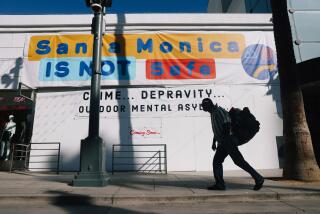Residents Fight Proposed Drop-In Center for Homeless
- Share via
Angry neighbors in Thousand Oaks have launched a drive to protect their block from becoming a congregating spot for the homeless.
Residents on Monday submitted petitions bearing 54 signatures and urging the City Council to reject a request by the Conejo Homeless Assistance Program to open a daytime drop-in center at 3059 Willow Lane.
It is the second time that the nonprofit homeless organization has encountered resistance.
Last year, residents of a neighborhood on Crescent Way argued that the center would lure derelicts into their area. Their sentiments were echoed by Willow Lane neighbors.
“I grew up in Santa Monica, and I know what the homeless are like. There’s a small percentage of homeless who are scary,” said Sue Widick, 30, who lives across the street from the proposed homeless center. “They are mentally ill, drug addicts or psychotic. If that’s 1 out of a 100, that’s one too many.”
James Kinville, a spokesman for the Conejo Homeless Assistance Program, said representatives have offered to buy the two-bedroom, 1,153-square-foot Willow Lane house, but that the sale is contingent on approval of a zoning change by the council.
The council is scheduled to consider the group’s request tonight at its regular meeting.
Several months ago, after polling some neighborhood residents, Conejo Homeless Assistance Program officials had reason to believe that the center had support, Kinville said.
The program operates a nighttime winter shelter from December to March but has no permanent year-round facility to serve the homeless during the day.
“This is a place where the homeless can have a mailing address, a telephone number where they can receive messages from the agencies they’re working with to solve their problems,” Kinville said.
He called neighbors’ fears unfounded.
The residence would serve as a drop-in facility that would be open between about 10 a.m. and 6 p.m. It would operate only five or six days a week and would not serve meals.
“The people who I have seen at the winter shelter program are not criminals or using drugs,” he said. “These are just people who are down on their luck.”
Roger Toft, chairman of the Conejo Homeless Assistance Program, said the group has worked for three years to find a site that would be welcomed by neighbors.
Last year, the group received a $50,000 grant from the city as down payment for a house that officials wanted to buy at 3046 Crescent Way in a neighborhood known as Old Town.
But after neighbors complained, the City Council unanimously rejected the idea and directed homeless activists to find a more suitable site in an industrial zone.
The center’s proponents say the new location is ideal because it is near businesses that already draw some foot and vehicle traffic.
“This is the only industrially zoned property for sale that offers some resemblance to a home,” Toft said. “It’s near the freeway. It’s near a Thousand Oaks Transit drop-off place. It’s near the center of town. A commercial site is totally inappropriate, and we didn’t want to put it next to McDonald’s.”
Some residents say that despite its industrial zoning, Willow Lane is badly suited for a homeless center.
Tom Mathers, 30, said he is worried because the street is poorly lighted, and thinks that an open field next to the proposed center might attract overnight visitors.
“This is not a business district. This is a residential area,” said Mathers. “I don’t want homeless people looking for work on my street.”
Rosemary Boykin, 60, who lives two doors away from the proposed center, said she has lived in her neighborhood since 1956. She initially supported the center in her neighborhood, but last weekend, she and other longtime residents signed the petition opposing it.
“We’ve had a nice, quiet neighborhood,” she said. “If the place is closed, they’re going to hang around.”
Dave Van Hooser, 60, who has lived on Willow Lane for 30 years, said the city is shifting the problem of providing for the homeless to neighborhoods where they are unwanted.
“I don’t see any reason why a few families should share the burden of caring for the homeless,” he said. “If they want to solve the problem, why don’t they give the grants to churches who are behind this movement, and they can have showers and mailboxes there?”
In an attempt to defuse the opposition, Kinville said he will ask the council not to make a decision until his group resolves the dispute with neighbors.
“Maybe it was false optimism that we felt we had a facility and a location that seemed (right). But it’s still too close to residential for some people’s comfort levels,” Kinville said. “If there are some misconceptions about what we are and what we’re doing there, we’d like to set the record straight.”
More to Read
Sign up for Essential California
The most important California stories and recommendations in your inbox every morning.
You may occasionally receive promotional content from the Los Angeles Times.













